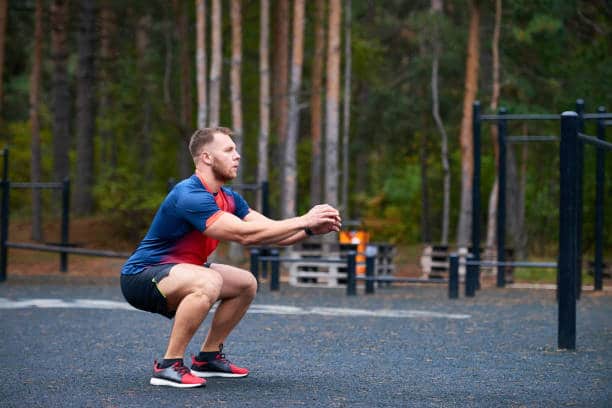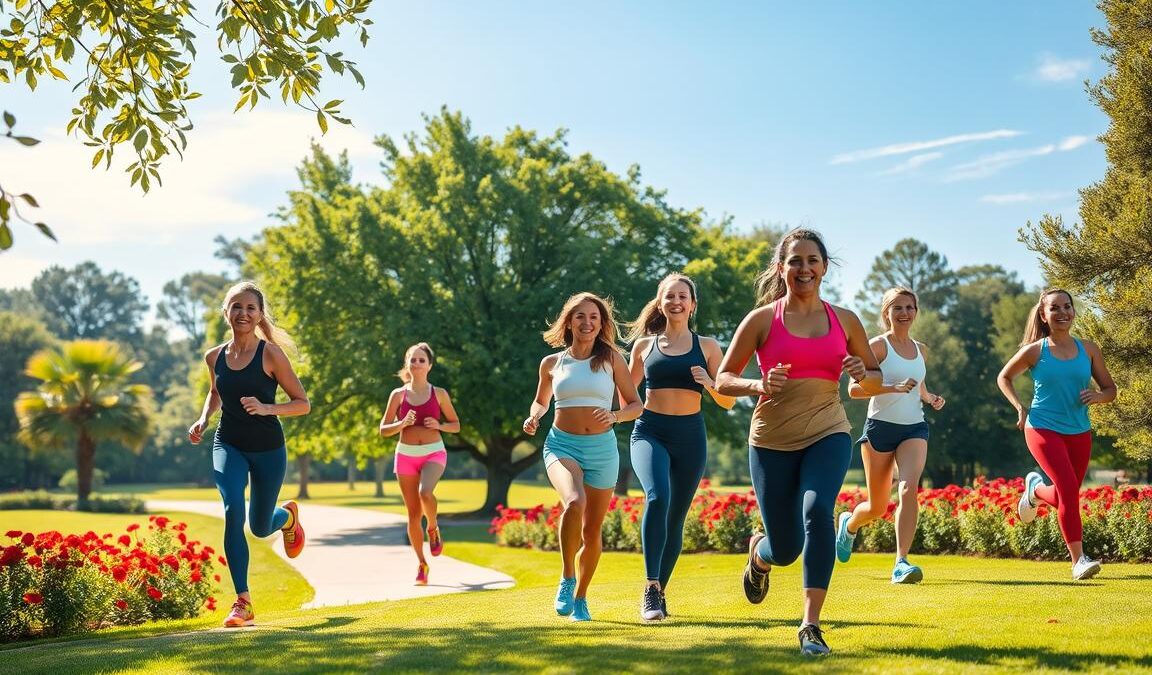
Effective Alternatives to Hack Squats for Strength
Did you know that sticking to the same workout routine can limit your muscle growth by up to 60%? To really boost your lower body strength and performance, it’s crucial to diversify your leg workouts. If you’re looking for an alternative exercises to hack squat that doesn’t rely on the hack squat machine, you’re in the right place.
In this article, I’ll introduce you to some fantastic non-machine squat alternatives that not only enhance quad strength but also improve overall leg power. Adding variety to your fitness routine helps prevent plateaus and promotes muscle growth by introducing new challenges.
Top fitness experts featured in magazines like Men’s Health and Shape highlight the benefits of varying your leg exercises. Research in sports medicine also confirms that mixing up your workouts supports better muscle and joint health. Whether you’re an experienced athlete or just getting started, incorporating these alternative exercises can make a significant difference.
Ready to find out which exercises can supercharge your leg strength training? Let’s dive in and explore the best alternative exercises to hack squats. From lunges to Bulgarian split squats, there are plenty of options to help you build powerful legs without relying solely on hack squats. One standout alternative is the box squat, an excellent compound movement that focuses on your quads, glutes, and hamstrings. To make the most of this exercise, be sure to follow proper box squat form tips, such as maintaining a strong core, keeping your knees aligned with your toes, and controlling the descent to fully engage your muscles.
Why Consider Alternatives to Hack Squats?

Many fitness enthusiasts are seeking alternatives to hack squats for various reasons. While hack squats are a popular choice, they come with some limitations. For one, not every gym has a hack squat machine, which can disrupt your ability to maintain a consistent workout routine.
Additionally, some people experience discomfort or knee strain with the hack squat machine. Athletes have shared that repetitive use of hack squats can worsen knee issues, making it wise to explore alternatives to avoid potential injuries.
Incorporating different exercises into your routine can also refresh your workouts. Adding variety boosts motivation and helps prevent boredom. Fitness professionals often highlight the psychological benefits of mixing up your exercises to keep things engaging.
Moreover, an orthopaedic specialist points out that avoiding exercises that put excessive strain on the knees, such as hack squats, can be better for long-term joint health. By exploring alternative exercises, you can reduce the risks associated with hack squats and avoid dependency on specific gym equipment.
Alternative Exercises to Hack Squat: Rear Foot Elevated Split Squats
A strong substitute for hack squats is the Bulgarian Split Squat or Rear Foot Elevated Split Squat. Concentrating on particular muscle groups and improving balance and muscle coordination are advantages of this exercise.
Benefits of Rear Foot Elevated Split Squats
One of the main benefits of split squats is their focus on unilateral leg training. By working each leg individually, you can address and correct any imbalances between your left and right sides. This type of training also boosts overall balance and stability. Plus, split squats significantly enhance muscle activation in your quads, glutes, and hamstrings, offering a well-rounded lower-body workout.
How to Perform Rear Foot Elevated Split Squats
To maximize the split squat benefits, following the correct split squat technique is crucial:
- Begin by standing about a step away from a bench. Place your non-working leg’s foot on the bench behind you.
- Keep your chest upright and core engaged. Lower your body by bending the front knee until your thigh is parallel to the ground.
- Push through the heel of your front foot to return to the starting position.
- Repeat the movement for the desired number of reps before switching legs.
Common Mistakes to Avoid
Avoiding common mistakes ensures the effectiveness of the split squat technique and prevents injuries:
- Incorrect Foot Placement: Make sure your front foot is far enough forward to keep the knee aligned with the ankle.
- Allowing the Knee to Cave In Keep your knee tracking over your toes to avoid unnecessary strain on your joints.
- Using Momentum: Focus on a controlled movement rather than bouncing up and down.
Bulgarian Split Squats

A strong substitute for hack squats is the Bulgarian Split Squat or Rear Foot Elevated Split Squat. Concentrating on particular muscle groups and improving balance and muscle coordination are advantages of this exercise.
Why Choose Bulgarian Split Squats?
Bulgarian split squats are an excellent exercise for sculpting your lower body. They naturally promote stability and strength by engaging your core throughout the movement. With their single-leg focus, Bulgarian split squats enhance muscle activation in the quadriceps, hamstrings, and glutes. The unilateral nature of the exercise also helps correct muscle imbalances, leading to more balanced development across both legs.
Step-by-Step Guide to Bulgarian Split Squats
- Start by standing a few feet in front of a bench or elevated surface.
- Place one foot behind you on the bench, ensuring your toes are pointing downwards.
- Keep your front foot flat on the ground and ensure your hip, knee, and ankle align.
- Slowly lower your hips, bending your front knee until your thigh is parallel to the ground.
- Push through your front heel to return to the starting position, maintaining balance and control throughout.
- Repeat the steps for the desired number of repetitions before switching legs.
Mastering Bulgarian split squats will significantly boost your stability and strength. This exercise is perfect for those aiming at comprehensive lower body sculpting. Remember, consistency and proper form are key to reaping the Bulgarian split squat advantages.
Leg Press Machine

The leg press machine is an excellent alternative for diversifying your leg workouts. One of its key benefits is that it reduces stress on the lower back compared to traditional squats, making it a great choice for those with back issues.
While both the leg press and hack squat machines are effective alternatives to squats, the leg press offers a different angle of muscle engagement. This machine places greater emphasis on the quadriceps, hamstrings, and glutes, which can significantly contribute to building lower body mass.
Here’s a comparison to highlight how the leg press machine stands out:
| Aspect | Leg Press | Hack Squat |
|---|---|---|
| Muscle Engagement | Quadriceps, Hamstrings, Glutes | Quadriceps, Glutes, Lower Back |
| Stress on Lower Back | Minimal | Moderate |
| Stability | High (Machine-Assisted) | Moderate (Free Movement) |
| Variation in Foot Placement | Extensive | Limited |
Incorporating the leg press into your routine can significantly enhance your lower body development. This machine is user-friendly and allows for controlled, safe repetitions. With an adjustable seat and foot platform, you can tailor your workout to target specific muscle groups effectively.
Many gym-goers value the leg press for its capacity to build muscle while minimizing the risk of injury. If you’re looking for effective squat alternatives for lower body mass building, the leg press machine is definitely worth considering.
Glute Bridge Variations
Glute bridge variants are a great substitute for hack squats if you’re looking to strengthen your glutes and add some variety to your fitness regimen. These exercises provide you with a full lower body workout by working your hamstrings in addition to your glutes.
Barbell Glute Bridge
For anyone concentrating on glute workouts, the Barbell Glute Bridge is a must-have exercise because it can dramatically improve glute development. You will need a barbell and a padded mat for comfort in order to complete this exercise. To begin, place your feet flat on the floor and sit on the ground with your upper back supported by a bench. Lift your hips until your body creates a straight line from your shoulders to your knees by rolling the barbell over your hips and using your core. Reduce and carry out again. This exercise works the hamstrings and lower back in addition to strengthening the glutes.
Single-Leg Glute Bridge
By increasing the difficulty and narrowing the focus of the glute workout, the Single-Leg Glute Bridge elevates the traditional glute bridge. Assume a prone position, bending one leg and placing your foot flat on the ground with your other leg extended. Make sure your extended leg stays straight by pressing through your heel and lifting your hips. This version strengthens your stability and balance in addition to targeting your glutes. To ensure balanced strength development, don’t forget to switch legs. Pay attention to form to steer clear of frequent mistakes like overarching your back.



